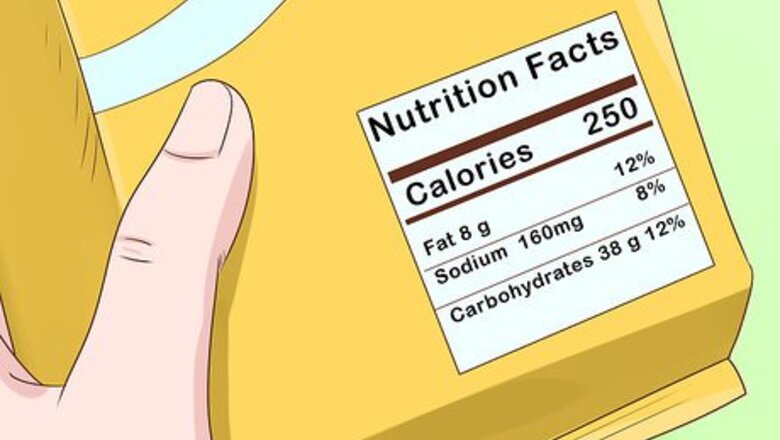
views
X
Research source
Determining the Calorie Content of Cat Foods

Check the label for the number of calories. In order to determine the number of calories in your cat's food, you should look at the food label to see if the calories are listed. Cat food companies are not required to put caloric information on the label. That being said, some brands will include caloric information. This is often the case for foods that are marketed as “light.”
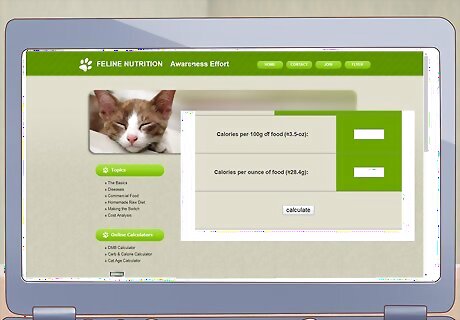
Calculate the calories using an online calculator. If you cannot find the caloric information printed on the label, then you can calculate the number of calories yourself. For example, use an online calorie calculator to determine the number of calories. In order to do this, you will need to look at the “Guaranteed Analysis” section of the food label. Here you will find all of the nutritional information regarding the percentage of protein, fiber, fat, minerals, etc. found within the food. You will then input these numbers into an online calculator, such as this one: http://fnae.org/carbcalorie.html The calculator will determine the number of calories per 100 grams of food. It will also provide you with information concerning the percentage of carbohydrates.
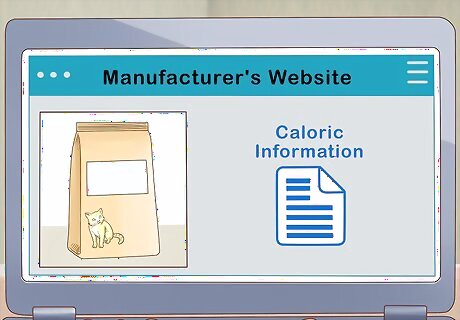
Look at the manufacturer's website for caloric information. In some instances you can find the caloric information regarding your cat's food by searching the specific product page on the manufacturer's website. In many instances the manufacturer will list the caloric information on the website, rather than directly on the label. You can also email or phone the manufacturer to inquire about this information.
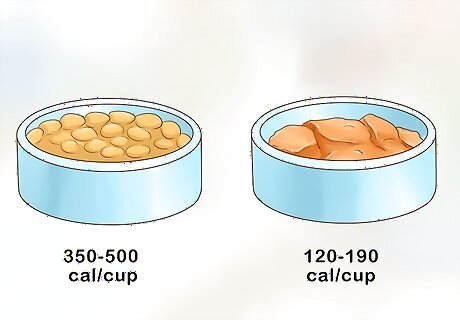
Compare the calories in wet and dry foods. Generally, dry cat food is more condensed and contains more calories than wet food. This means that your cat could get the same amount of calories by eating a small amount of dry food and a larger serving of wet food. In most cases, the calorie count for dry food is anywhere between 350 and 500 calories per cup (0.2 liters), whereas wet food ranges from 120 to 190 calories per cup (0.2 liters). Different proteins also have different average calorie levels. For instance, chicken-based foods typically have more calories than turkey, fish, or beef-based cat foods.
Calculating Your Cat's Caloric Needs

Talk with your vet. It is also important to have a good understanding of how many calories your particular cat needs to consume each day. This amount will vary between cats and is usually based on their age, weight, activity level, and whether or not they have been spayed or neutered. Ask your vet to assess your cat and determine the proper number of calories it should consume each day. In most instances your vet will provide you with an ideal caloric range for your cat.
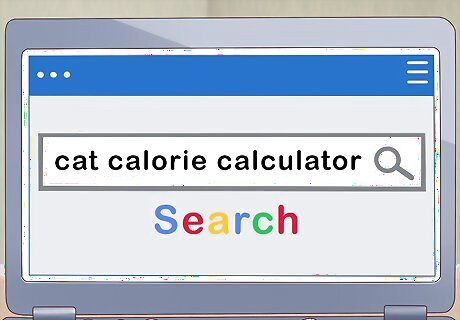
Use an online calculator. It is also possible to discover your cat's caloric needs using an online calculator. Complete an online search for a “cat calorie calculator.” You will then need to input your cat's weight and indicate if your cat has been spayed or neutered. You will also be asked if your cat is a kitten. This calculator will provide a general indication of your cat's caloric needs, but is not as accurate as a vet assessment.

Calculate the number of calories yourself. It is also possible to calculate the number of calories your cat needs by using a mathematical formula: Cal=(weight kg^0.75)*70*Factor. You need to calculate your cat's weight in kilograms to the power of 0.75. Then multiply that number by 70. This will give your cat's Resting Energy Requirements (RER). You then need to adjust that calculation slightly depending on your cat's age and activity level. For a normal adult cat you would multiply this number by 1.2. For example, an adult cat that has been neutered and that weighs 10lbs (4.54kg) will use the following formula to calculate their desired calories: (4.54^0.75)*70*1.2=261 calories/day. If this were a kitten, you would adjust the factor number from 1.2 to 2. Alternatively, if the cat was overweight the factor would be adjusted from 1.2 to 0.8.
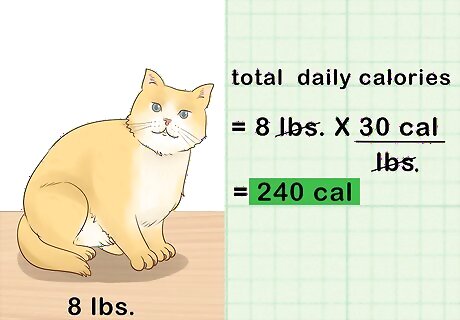
Understand the average caloric intake for cats. An adult cat needs approximately 25 to 35 calories per pound per day. The number varies slightly based on activity level. For example, an active eight pound adult cat would need to consume about 30 calories per pound per day for a total of 240 calories. Kittens need to eat slightly more because they are still growing. As a result, you should feed them frequent meals (approximately four per day) and they should eat as much as they can until they reach six months of age. At this point you can begin feeding them like an adult cat. Monitor your kitten's weight and development to ensure they are not over or under eating.
Ensuring Your Cat Gets the Proper Number of Calories
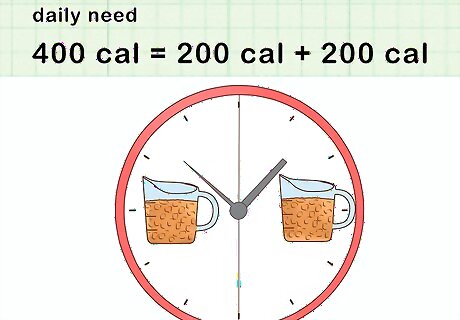
Determine your cat's proper daily feeding portion. Once you have determined the number of calories your cat needs to eat each day and the number of calories within its food, you can calculate how much food to feed your cat each day. For example, if your cat needs 400 calories per day and you are feeding your cat a dry food that contains 200 calories per cup (0.2 liters), then you would need to feed your cat two cups (0.5 liters) of food per day. You could divide this up into two meals or allow your cat to graze all day and only provide a maximum of two cups of food.
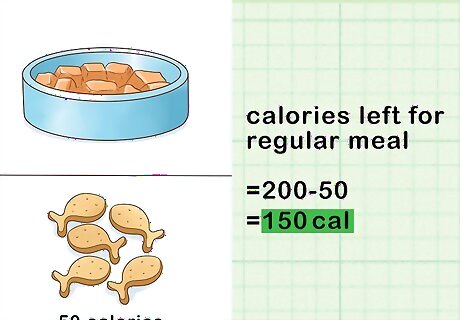
Subtract any calories that are given in the form of treats. You should also take into consideration the calories contained in any treats that you give your cat. For example, if your cat eats 50 calories worth of treats each day, then you need to reduce the amount of calories they receive through their regular meals. For example, if your cat needs 200 calories per day and they eat 50 calories in treats, they would have 150 calories left to receive from food. If their food contains 100 calories per cup (0.2 liters) then they would need 1.5 cups (0.4 liters) of food each day.
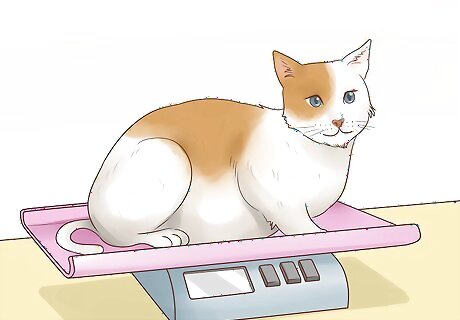
Monitor your cat's weight. You will likely need to change the amount of food you give your cat throughout their lifespan. This is because their activity level and metabolism may change as they age. Monitor your cat's weight and adjust their caloric intake accordingly. For example, if your cat begins to gain weight, you may need to start feeding them less calories each day. Similarly, if they start losing weight begin feeding them more calories. Calculate their caloric needs by using their desired weight instead of their actual weight. This will help you determine the exact amount you should be feeding them. In order to lose weight, your cat will need to eat less than the recommended caloric intake for its weight. Consult with your vet to determine how much and how quickly to reduce your cat's caloric intake in order to prevent starving or underfeeding your cat.


















Comments
0 comment